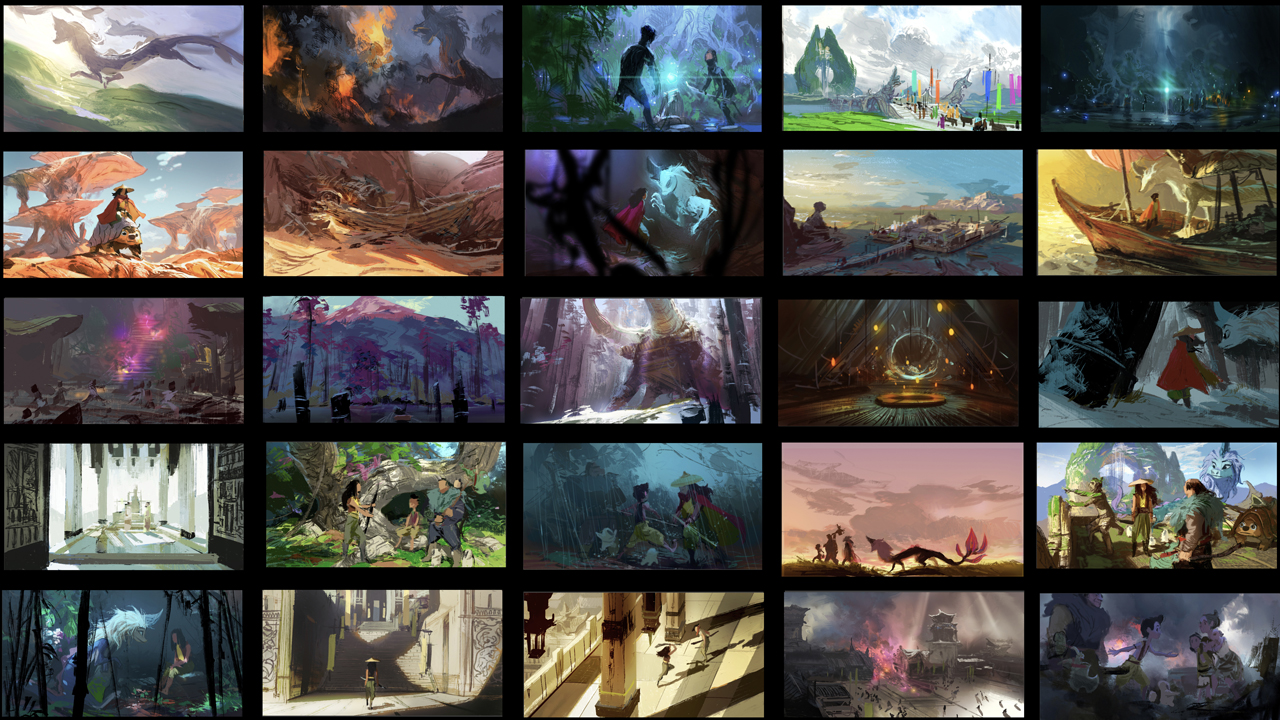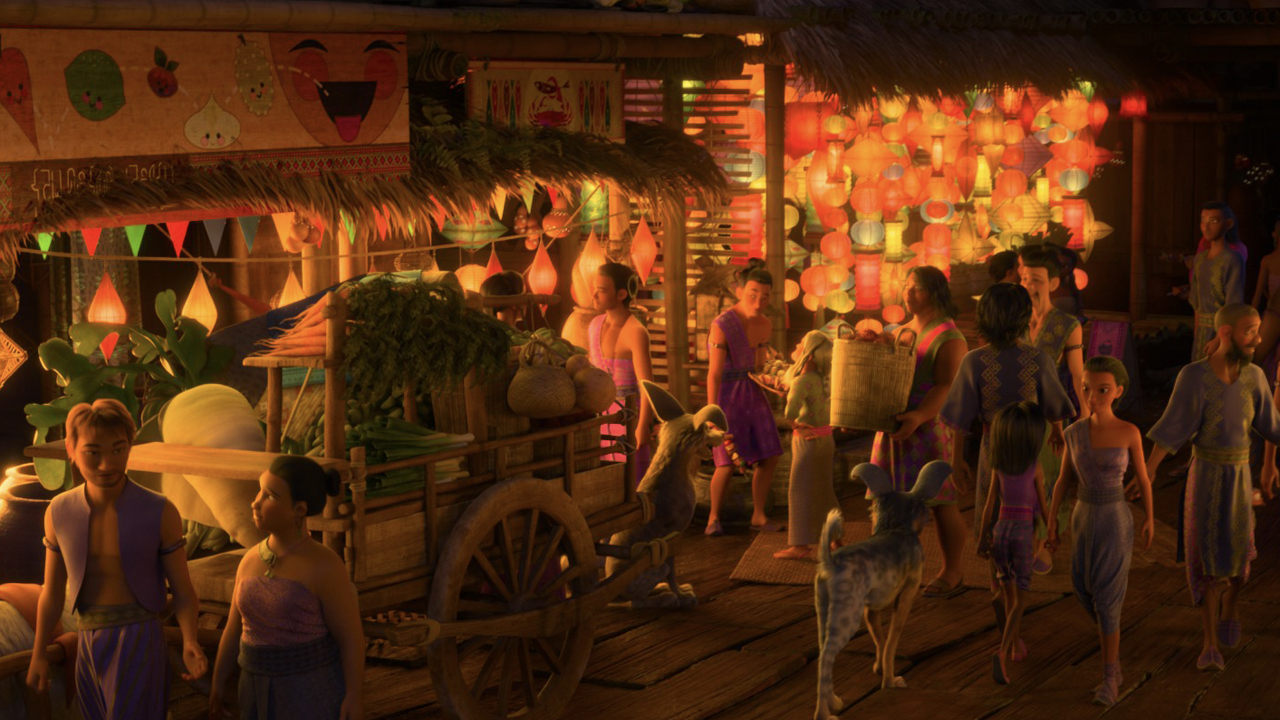Inside Raya and the Last Dragon, Disney's celebration of Southeast Asian culture

Raya and the Last Dragon is an animated Disney movie with plenty to say. In a world where scepticism and division have been rife in recent years, the film's exploration of trust, unity and friendship has never felt more pressing.
Vital as it is for any film to broach such themes, however, it's Raya's approach to (and examination of) representation and inclusion that stands it out from its contemporaries.
With Disney taking steps to address its controversial past regarding racial stereotypes, Raya and the Last Dragon feels like a step in the right direction, and the significance of putting diversity front and center of the studio's latest animated flick isn't lost on the film's crew.
- How to watch Raya and the Last Dragon online
- Here's our Raya and the Last Dragon review
- This is everything you need to know about Disney Plus
Ahead of Raya's initial Disney Plus Premier Access launch back in March (the movie is now available to all Disney Plus subscribers), TechRadar sat down with the film's Head of Story Fawn Veerasunthorn and Disney environment modeler Liza Rhea to discuss how Raya reflects Disney's progression towards becoming a more inclusive studio.
We also talked about how the movie's cast helped with the push towards greater representation and the difficulties of making a film during the Covid-19 pandemic.
Movie making during a pandemic

Raya and the Last Dragon follows Raya (Kelly Marie Tran), a warrior on a quest to find the last living Dragon Sisu (Awkwafina) after a cataclysmic event occurs. The Druun – a mindless, evil plague born from negativity – has wiped out large swathes of Kumandra’s human population, and it’s up to Raya to find Sisu and destroy the Druun threat for good.
Doing so won’t be easy. Sisu’s Dragon Gem – a magical stone that ended the Druun’s first attack 500 years earlier – was destroyed during a mass altercation between Kumandra’s warring factions, and it's up to Raya to repair the gem and restore peace to her world.
Sign up for breaking news, reviews, opinion, top tech deals, and more.
The plot of Disney’s latest movie may be one built around working together to achieve a common goal, but little did the film’s 900-strong crew know that its themes would soon cross over into the real world.
At the height of Raya's production in March 2020, the Covid-19 pandemic struck. With the team now forced to finish development remotely, numerous problems emerged. Equipment had to be sourced and delivered to over 400 homes, internet issues needed addressing, workflows and pipelines were altered and spontaneous visits to people’s offices were no more.
In Veerasunthorn and Rhea's cases, though, those issues paled in comparison to a much bigger problem – family.
“One of the biggest challenges was the work-life balance,” Veerasunthorn says. “Suddenly, the schools closed so I had a child – who had been in pre-school – who was home all of the time and running around. She had to come to the meetings [about Raya's production] as there were no other options.”
“I was five-and-a-half months pregnant when lockdown happened,” Rhea adds. “I was concerned with how I would work ergonomically from home. But Disney worked so quickly to get us everything we needed. It was something we had to quickly figure out. ‘When could we do the work?’ and ‘When can we meet?’, but there was a lot of wiggle room with figuring out how to get that up and running again.”
Celebrating Southeast Asian culture

Pre-pandemic, the biggest challenge that the Raya team faced was authentically recreating a world region often overlooked in mainstream popular culture – Southeast Asia, which Disney was yet to explore in great detail in its movies.
While the film is set in the fictional land of Kumandra, paying tribute to the variety of real world cultures and traditions in Southeast Asia was a key goal throughout production.
In order to accurately portray Southeast Asia’s heritage and lifestyles on screen, the Raya team comprised Disney employees with ties to the region and experts from different real-world nations.
Thai-born Veerasunthorn, alongside screenwriters Adele Lim and Qui Nguyen, whose roots reside in Malaysia and Vietnam respectively, provided insight into the movie’s many details. Disney’s Southeast Story Trust – composed of leading academics headed up by Lao visual anthropologist Steve Arounsack – also ensured that details including costumes, food items, combat styles, and Southeast Asia's tradition of strong female leaders were faithfully recreated.
The pressure to authentically represent hers and other cultures, in Veerasunthorn’s opinion, was evident from the beginning. Still, an overall sense of motivation to provide true Southeast Asian representation eventually trumped any worries that she had.
“There are lots of ways of life that overlap between different cultures in this region,” Veerasunthorn explains. “The close proximity to the water and its importance in our rituals, the awareness and respect for the invisible world, and the importance of family and respect for your elders. This will be the first time I’ve ever seen my culture portrayed on this scale before, so there’s a need for doing it right. When you think of Asian representation, people think of East Asia. I think this film will be able to show that there are different, diverse and beautiful cultures within the continent.”
I was five-and-a-half months pregnant when lockdown happened
Liza Rhea, Disney environment modeler
For team members without those experiences, research trips (taken before the pandemic hit) to nations including Indonesia, Thailand and Cambodia helped to immerse them in different cultures. Communication between Raya’s Southeast Asian consultants and the film’s many departments, such as modeling and animation, was also vital to ensure that Kumandra’s environments, architecture and inhabitants were accurately realized.
“Even though it is a fantasy adventure film, you can really feel them [Southeast Asian cultures] in the environments and artwork,” Rhea said. “As modelers, we worked closely with the art director (David Wormsley) and visual effects team, and we have a library of photos and videos to look at and really get ourselves in that headspace. I think when people see the film, they’ll see the environments are so rich with inspiration from Southeast Asian cultures.”
Given the distinctions between Southeast Asia's nations and cultures, it was crucial that each was uniquely represented. Kumandra's five lands – Heart, Talon, Fang, Spine and Tail – were all given their own personalities and aesthetics to provide them with individual identities, and tie back into the movie's aim of inclusion and diversity.
Whilst each land's environments differed in style and tone, there is one constant throughout that harks back to a universal Southeast Asian heritage – the prominent role that water plays in the region.
With Sisu modeled on Southeast Asia’s serpentine Naga dragons, and water’s historical context in its culture, Rhea’s experiences of working on another water-based movie – Frozen 2 – helped to create the right surroundings for Raya’s aquatic sequences.
“Our departments are broken up into modeling and effects, and the latter are the ones who handle all of the water,” Rhea says. “They also handled that for Raya, but we [the modeling team] had to create the world for the water to flow into, so it is a lot of back and forth and collaboration working with those departments.”
Character charm and missing musicals

Selecting the right actors for Raya's various roles was equally important from a representation standpoint. Character whitewashing has become a hugely controversial topic within the film industry and, only recently, Marvel Studios (a subsidiary of Disney) admitted its regret over casting a white actor – Tilda Swinton – as The Ancient One, an individual of Himilayan descent, in 2016's Doctor Strange.
As Disney continues to wrestle with, acknowledge and address its own contentious history with cultural stereotypes, Raya's predominantly Asian cast feels like a step in the right direction – even though the movie has drawn criticism from some quarters for its lack of Southeast Asian actor representation.
Disney, then, still has some way to go with rectifying such issues. Where the studio excels, though, is creating believable and relatable relationships between its movies' various protagonists. In Raya and Sisu, Disney's latest animated feature has two such individuals who are brought to life in stellar fashion by their voice actors.
“Every time Awkwafina recorded I couldn’t wait to hear what she brought,” Veerasunthorn says. “Sometimes she would adlib and the directors would encourage that. And, for Kelly, I think there’s a subtlety in her acting that comes across as a warrior and a very likable person that you want to get to know. You want to show strength but not in a way that’s stoic or serious. I think Kelly really brought a good balance to her.”
Raya and the Last Dragon has plenty of traditional Disney characteristics, but perhaps its most surprising exclusion is sing-along tunes. As good as James Newton Howard’s moving score is, some fans may be disappointed that Raya’s cast doesn’t regularly break into song. Veerasunthorn reveals, however, that this was never the plan.
“It didn’t start as a musical to begin with,” she explains. “Our directors were intent on trying to make something contemporary, so we had to use split-screen, quick cuts, and comedy that the team really enjoys. It was cool that we had a film that looks like a historical period piece. The story is classical but still has all the heart and fun of Disney.”
When you think of Asian representation, people think of East Asia. I think this film will be able to show diverse cultures within the continent.
Head of Story Fawn Veerasunthorn
Raya and the Last Dragon represents an important step forward for Disney. It isn't the first of its many movies to begin delivering on its promise for greater representation, but it's one that celebrates the originality and uniqueness of Southeast Asia in such vivid detail.
With its Stories Matter program leading the charge in redefining how The Walt Disney Company reflects the world around it, we should see a more diverse lineup of Disney films in the future. Providing a space for stories to be told about different cultures and world regions is imperative in the present day, and it's a hope that many viewers hope that Disney follows through on.
“We knew that we wanted to make our film a contemporary subject so that the audiences of today can enjoy it,” Veerasunthorn explains. “But we also want people to have a conversation with their family members about these topics [surrounding diversity and inclusion]. As filmmakers, we’re aware that we should put that into the film, not just for specificity but for authenticity for the audience in those region, too."
Raya and the Last Dragon is now available to stream for everyone on Disney Plus.
- Here's everything you need to about Loki on Disney Plus
As TechRadar's senior entertainment reporter, Tom covers all of the latest movies, TV shows, and streaming service news that you need to know about. You'll regularly find him writing about the Marvel Cinematic Universe, Star Wars, Netflix, Prime Video, Disney Plus, and many other topics of interest.
An NCTJ-accredited journalist, Tom also writes reviews, analytical articles, opinion pieces, and interview-led features on the biggest franchises, actors, directors and other industry leaders. You may see his quotes pop up in the odd official Marvel Studios video, too, such as this Moon Knight TV spot.
Away from work, Tom can be found checking out the latest video games, immersing himself in his favorite sporting pastime of football, reading the many unread books on his shelf, staying fit at the gym, and petting every dog he comes across.
Got a scoop, interesting story, or an intriguing angle on the latest news in entertainment? Feel free to drop him a line.